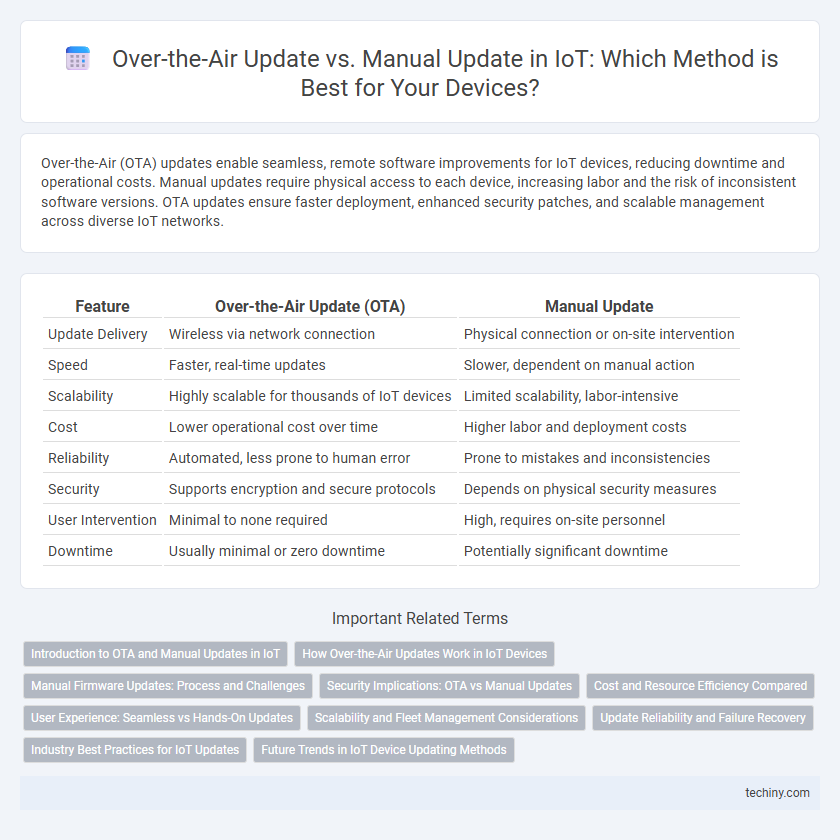Over-the-Air (OTA) updates enable seamless, remote software improvements for IoT devices, reducing downtime and operational costs. Manual updates require physical access to each device, increasing labor and the risk of inconsistent software versions. OTA updates ensure faster deployment, enhanced security patches, and scalable management across diverse IoT networks.
Table of Comparison
| Feature | Over-the-Air Update (OTA) | Manual Update |
|---|---|---|
| Update Delivery | Wireless via network connection | Physical connection or on-site intervention |
| Speed | Faster, real-time updates | Slower, dependent on manual action |
| Scalability | Highly scalable for thousands of IoT devices | Limited scalability, labor-intensive |
| Cost | Lower operational cost over time | Higher labor and deployment costs |
| Reliability | Automated, less prone to human error | Prone to mistakes and inconsistencies |
| Security | Supports encryption and secure protocols | Depends on physical security measures |
| User Intervention | Minimal to none required | High, requires on-site personnel |
| Downtime | Usually minimal or zero downtime | Potentially significant downtime |
Introduction to OTA and Manual Updates in IoT
Over-the-Air (OTA) updates in IoT enable remote software and firmware deployment, enhancing device security and functionality without physical intervention. Manual updates require direct device access, often leading to increased downtime and operational costs. OTA technology streamlines maintenance by automating update distribution across large-scale IoT networks, ensuring timely patching and improved device lifecycle management.
How Over-the-Air Updates Work in IoT Devices
Over-the-Air (OTA) updates in IoT devices enable remote firmware and software upgrades through wireless communication protocols like Wi-Fi, LTE, or Bluetooth, eliminating the need for physical intervention. These updates are securely transmitted to IoT devices, where embedded bootloaders verify the update's integrity before installation to ensure system stability and prevent bricking. OTA updates support real-time enhancements, security patches, and feature additions, significantly reducing maintenance costs compared to manual updates requiring onsite access.
Manual Firmware Updates: Process and Challenges
Manual firmware updates in Internet of Things (IoT) devices require physical access to each device, often involving connecting via USB or serial interfaces to upload new software versions. This process is time-consuming and prone to human errors such as incorrect firmware installation or incomplete updates, leading to device malfunctions. Challenges include logistical complexity, increased operational costs, and security risks due to lack of automated verification and the possibility of introducing outdated or compromised firmware.
Security Implications: OTA vs Manual Updates
Over-the-Air (OTA) updates in the Internet of Things provide enhanced security by enabling timely patches and mitigations against emerging vulnerabilities without physical access to devices. Manual updates, while potentially less exposed to remote exploitation during the update process, risk delayed deployment leading to prolonged exposure to critical threats. OTA update frameworks must incorporate robust authentication, encryption, and integrity verification mechanisms to prevent unauthorized access and ensure secure firmware delivery.
Cost and Resource Efficiency Compared
Over-the-Air (OTA) updates significantly reduce operational costs by eliminating the need for physical access to each device, which lowers labor expenses and downtime. OTA updates streamline resource efficiency through automated, scalable deployment, enabling simultaneous updates across thousands of IoT devices without interrupting their functionality. In contrast, manual updates require substantial time and human resources, increasing labor costs and the risk of inconsistent software versions across the network.
User Experience: Seamless vs Hands-On Updates
Over-the-Air (OTA) updates provide a seamless user experience by automatically delivering software improvements and security patches without requiring user intervention, minimizing downtime and maintaining device functionality. Manual updates demand hands-on involvement, requiring users to download and install updates physically, which can lead to delays and potential user errors. OTA's convenience enhances user satisfaction and device reliability in Internet of Things ecosystems.
Scalability and Fleet Management Considerations
Over-the-Air (OTA) updates enable scalable fleet management by remotely deploying software upgrades to thousands of IoT devices simultaneously, reducing downtime and operational costs. Manual updates require physical access to each device, resulting in high labor expenses and delayed implementation across large fleets. Efficient OTA update frameworks enhance seamless scalability and real-time device monitoring, essential for managing extensive IoT ecosystems.
Update Reliability and Failure Recovery
Over-the-Air (OTA) updates provide enhanced update reliability by enabling remote deployment of patches and firmware with minimal downtime and automated integrity checks, reducing human error compared to Manual Updates. OTA systems incorporate robust failure recovery mechanisms such as rollback capabilities and checkpointing to ensure devices revert to the last stable state if an update fails, safeguarding IoT device functionality. In contrast, Manual Updates rely heavily on operator intervention, increasing the risk of incomplete updates and prolonged recovery times, which can compromise device continuity and security.
Industry Best Practices for IoT Updates
Over-the-Air (OTA) updates are the industry best practice for IoT devices, enabling efficient and secure remote firmware and software enhancements without physical device access. OTA updates minimize downtime, reduce operational costs, and improve device scalability by automating patch management and feature deployment. Manual updates, while sometimes necessary in constrained environments, pose risks of inconsistency, delays, and increased labor, making OTA the preferred method for maintaining IoT device integrity and performance.
Future Trends in IoT Device Updating Methods
Over-the-Air (OTA) updates dominate future IoT device maintenance strategies due to scalability and efficiency in managing billions of connected devices. Manual updates remain limited to niche applications where security or physical access constraints prevail, but their usage is declining sharply. Emerging trends emphasize AI-driven predictive update scheduling and edge computing integration to minimize downtime and optimize bandwidth usage during OTA deployments.
Over-the-Air Update vs Manual Update Infographic

 techiny.com
techiny.com